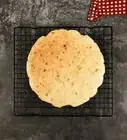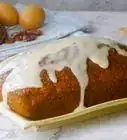This article was co-authored by wikiHow Staff. Our trained team of editors and researchers validate articles for accuracy and comprehensiveness. wikiHow's Content Management Team carefully monitors the work from our editorial staff to ensure that each article is backed by trusted research and meets our high quality standards.
The wikiHow Video Team also followed the article's instructions and verified that they work.
This article has been viewed 131,950 times.
Learn more...
Coconut cake is a yummy, refreshing treat with a bold flavor that your guests are sure to love. If you’re an experienced baker or new to the kitchen, this made-from-scratch coconut cake is a classic and easy dessert that you can whip up for any occasion. You can even make your own homemade coconut frosting, and serve the cake with fresh fruit or ice cream!
Ingredients
- 3 sticks of unsalted butter, softened
- 2 cups (400 g) of sugar
- 5 extra large eggs, room temperature
- 1.5 teaspoons (7.4 mL) of pure vanilla extract
- 1.5 teaspoons (7.4 mL) of pure almond extract
- 3 cups (360 g) of all-purpose flour
- 1 tsp (4 g) of baking powder
- ½ tsp (2 g) of baking soda
- ½ tsp (2.5 g) of salt
- 1 cup (240 mL) of milk
- 4 oz (113 g) of sweetened, shredded coconut
- 8 oz (225 g) of cream cheese, softened
- 1 stick of unsalted butter, softened
- 3 tablespoons (44 mL) of milk
- 1 teaspoon (4.9 mL) of vanilla extract
- 3 cups (375 g) of powdered sugar
- 3 cups (225 g) of coconut flakes
Yield: 6-8 servings of cake
Steps
Baking a Classic Coconut Cake
-
1Preheat the oven to 350 °F (177 °C). Preheating your oven is especially important for baking, since the baking powder and baking soda both will only work in high heat. Make sure your oven is set to the correct temperature, which should take around 15 minutes. This time can vary depending on your oven, so pay attention to the preheating indicator light on your oven.[1]
- If you don’t preheat your oven, your cake might not bake all the way, or you may have to bake it for a longer time. This can also lead to a cake that is unevenly baked.
- If your oven doesn’t have an indicator light, use a thermometer to judge the temperature of the oven.
-
2Grease 3 circular 9 in (23 cm) pans and line them with parchment paper. Rub butter or margarine into the pans along the bottom and sides. Then, cut pieces of parchment paper that are large enough to line your pans, and press the paper into the pan so that it’s touching the bottom and the sides.[2]
- If you don’t have extra butter or margarine, you can use a baking spray to grease your pans.
- Don’t worry if the parchment paper won’t stay in the greased pans. Once you add the batter, the paper will fall into the pan.
Advertisement -
3Cream the butter and sugar on medium-high for 3-5 minutes. Add the 3 sticks of softened butter and 2 cups (400 g) of sugar into the bowl of an electric mixer and lower and lock the arm. Slowly increase the speed of the mixer until you reach medium-high, and then allow the butter and sugar to combine for at least 3 minutes. They should be light yellow and have a fluffy texture.[3]
- You may need to use a spatula to push the ingredients down into the bowl as they mix.
- It’s important to use soften butter since it will combine more easily with the sugar to form a creamy mixture. You can soften your butter by leaving it outside of the refrigerator for 30 minutes, or microwave it on the defrost setting for 15 seconds.
-
4Add the eggs to the mixer 1 at a time, scraping the batter down. Slow the speed of the mixer to medium, and crack 1 egg into the mixer. Then, wait for that egg to mix into the batter before adding another. Continue until you’ve added all of your eggs, and then mix the batter for an additional 1-2 minutes to ensure that the eggs are combined.[4]
- After you add the eggs, you may have to scrape the batter down the side of the bowl with the spatula before continuing.
-
5Pour in the vanilla and almond extracts, mixing at a medium speed. Measure out 1.5 teaspoons (7.4 mL) of pure vanilla extract and 1.5 teaspoons (7.4 mL) of pure almond extract and put them in the bowl together. Let the batter mix for another 30 seconds.[5]
- Keep in mind that the batter might look clumpy or “curdled” at this point. This is normal and the clumps will go away when you add the dry ingredients!
-
6Mix the dry ingredients thoroughly in a separate bowl. Pour 3 cups (360 g) of all-purpose flour, 1 tsp (4 g) of baking powder, ½ tsp (2 g) of baking soda, and ½ tsp (2.5 g) of salt into the bowl and use a dry spatula to stir them for at least 1 minute to make an even mixture. If you have a sifter, you can sift the ingredients together to combine them more easily![6]
Did you know? Mixing your dry ingredients separately from the rest of your ingredients prevents the dry ingredients from interacting with the wet ingredients separately, which can cause the cake to become crumbly.
-
7Alternate between adding milk and the dry ingredients into the mixer. Change the mixer speed to low and divide the dry ingredients into thirds. Then, add ⅓ of the dry ingredients followed by 1⁄2 cup (120 mL) of the milk. Pour in another ⅓ of the dry ingredients and then the remaining 0.5 cups (120 mL) of milk. Add the rest of the dry ingredients, and mix everything until combined.[7]
- Remember to let the batter mix for at least 15-20 seconds in between adding ingredients to give them time to combine.
-
8Fold in the coconut by hand when the mixture is evenly combined. Turn off the mixer and remove the bowl so you can mix by hand. Pour 4 oz (113 g) of sweetened, shredded coconut into the batter and use a spatula to distribute the coconut evenly throughout the batter. Mix for about 1-2 minutes to prevent clumping.[8]
- Avoid mixing the batter by hand for too long, as this can incorporate more air into the batter, making it rise too much in the oven.
-
9Divide the batter evenly between the 3 pans and bake for 25-30 minutes. Pour the batter into the pans and then place them on the center rack of your preheated oven. After 25 minutes, remove the cakes from the oven and push a toothpick into the center of each. If the toothpick comes out clean, the cake is done! If not, bake the cakes for an additional 5 minutes.[9]
- You can bake all of the cakes together at one time, but be sure to check to make sure each one is done.
-
10Let the cakes cool completely before adding your frosting. Allow the pans to cool for 5 minutes before removing the cakes from the pans. Then, place the cakes on a wire rack to cool for an additional 1-2 hours. When the cakes are completely cool to the touch, you can begin frosting them.[10]
- If you’re not going to frost the cakes immediately, you can place the baked cakes into the fridge until you’re ready to frost them.
- As the cakes are cooling, you can start making your frosting for the cake!
Making Coconut Cream Cheese Frosting
-
1Beat the cream cheese and butter at a medium speed until they’re creamy. Put 8 oz (225 g) of softened cream cheese and 1 stick of softened unsalted butter in the bowl of an electric mixer. Gradually increase the speed to medium-high, and whip the ingredients together for about 3 minutes until the mixture has a smooth consistency.[11]
- If you don’t have an electric mixer available, you can use a hand mixer and a bowl to combine the ingredients.
- Avoid using cream cheese directly from the refrigerator, since it will stick together and form clumps while mixing. To soften the cream cheese, let it sit outside of the refrigerator for 30 minutes or microwave the block of cream cheese in a bowl for 15 seconds.
-
2Pour in the milk and vanilla, mixing the frosting well. With the mixer still running, add 3 tablespoons (44 mL) of milk and 1 teaspoon (4.9 mL) of vanilla extract. Continue mixing the frosting until it’s a smooth consistency and has an even color with no lumps or pockets of liquid as you mix it.[12]
Tip: If you want an even stronger coconut flavor, you can use the same amount of coconut milk instead of regular milk!
-
3Add the sugar gradually, beating the frosting until it’s smooth. Pour the sugar into the mixture 1 cup (125 g) at a time, letting the frosting mix for about 15-20 seconds before adding more. Once you’ve added all of the sugar, let the mixer run for 3-4 more minutes to get rid of any clumps of sugar. Gradually decrease the mixer speed until it’s turned off, and run a spatula through the frosting to ensure that there are no pockets of sugar.[13]
- The frosting should be smooth and white, with a creamy consistency that holds its shape slightly when you lift the spatula.
-
4Stir in the coconut by hand to complete the frosting. Pour 3 cups (225 g) of coconut flakes into the bowl and use a rubber spatula to fold the coconut into the frosting. Continue mixing until the flakes are evenly distributed throughout the frosting, and then set the frosting aside until you’re ready to decorate your cake.[14]
- You can also save some of the coconut flakes and sprinkle them on top of your cake as a finishing touch!
- If you’re going to decorate your cake within 1-2 hours, you don’t have to refrigerate the frosting. Simply cover the top of the bowl with a napkin or paper towel and leave it on the counter until you’re ready to decorate. If you’re waiting longer than 2 hours, refrigerate the frosting until about 1 hour before you’re ready to ice the cake.
-
5Frost and layer your cake as desired. Place one layer of the cake onto a flat serving plate with the top down, and spread a scoop of frosting evenly over the top of cake, placing another layer on top. Keep your frosting layers about 1⁄4 inch (0.64 cm) thick. Continue frosting and layering the cake until you’ve used all of the cake, and then apply a layer of frosting along the top and outside. Sprinkle the top with leftover coconut flakes for a garnish![15]
- You can serve the cake immediately at room temperature, or put it in the refrigerator to store it for up to 6 hours before serving it.
- Keep the cake stored in the refrigerator for up to a week. After a week, throw away any leftovers.
Community Q&A
-
QuestionMust I use desiccated coconut?
 Amy273Community AnswerYes - it is ideal to make a good coconut cake, otherwise it could be a choking hazard due to the coarse coconut. However, if you do not have desiccated coconut, you can simply buy a coconut and then grate the amount of coconut you need for your cake.
Amy273Community AnswerYes - it is ideal to make a good coconut cake, otherwise it could be a choking hazard due to the coarse coconut. However, if you do not have desiccated coconut, you can simply buy a coconut and then grate the amount of coconut you need for your cake. -
QuestionHow many days will the cake last?
 Community AnswerMost cakes last for about 3 to 4 days if you keep them in a container and don't let the air in.
Community AnswerMost cakes last for about 3 to 4 days if you keep them in a container and don't let the air in. -
QuestionIs 240 g of butter really necessary?
 Community Answer240 g might be too much. It says "240 g / 8 oz soft butter" in the recipe, but 8 oz is actually only about 225 g of butter. If you have the time on your hands, you can try it with both 240 and 220 g of butter; it might not make a big difference.
Community Answer240 g might be too much. It says "240 g / 8 oz soft butter" in the recipe, but 8 oz is actually only about 225 g of butter. If you have the time on your hands, you can try it with both 240 and 220 g of butter; it might not make a big difference.
Things You'll Need
- 3 circular 9 inches (23 cm) cake pans
- Parchment paper
- Electric mixer
- Spatula
- Serving plate
References
- ↑ https://www.foodnetwork.com/recipes/ina-garten/coconut-cake-recipe-1947027
- ↑ https://thestayathomechef.com/coconut-cake/
- ↑ https://www.foodnetwork.com/recipes/ina-garten/coconut-cake-recipe-1947027
- ↑ https://www.foodnetwork.com/recipes/ina-garten/coconut-cake-recipe-1947027
- ↑ https://www.foodnetwork.com/recipes/ina-garten/coconut-cake-recipe-1947027
- ↑ https://www.foodnetwork.com/recipes/ina-garten/coconut-cake-recipe-1947027
- ↑ https://www.foodnetwork.com/recipes/ina-garten/coconut-cake-recipe-1947027
- ↑ https://www.foodnetwork.com/recipes/ina-garten/coconut-cake-recipe-1947027
- ↑ https://thestayathomechef.com/coconut-cake/
- ↑ https://thestayathomechef.com/coconut-cake/
- ↑ https://www.myrecipes.com/recipe/coconut-cream-cheese-frosting-4
- ↑ https://www.myrecipes.com/recipe/coconut-cream-cheese-frosting-4
- ↑ https://www.myrecipes.com/recipe/coconut-cream-cheese-frosting-4
- ↑ https://www.myrecipes.com/recipe/coconut-cream-cheese-frosting-4
- ↑ https://www.foodnetwork.com/recipes/ina-garten/coconut-cake-recipe-1947027
About This Article
To bake a classic coconut cake, cream together softened butter and white sugar until the mixture is light yellow and fluffy. Add the eggs 1 at a time, scraping the sides of the bowl after you mix in each one, then stir vanilla and almond extract into the bowl. In a separate bowl, mix together all-purpose flour, baking powder, baking soda, and salt. Alternate adding the dry ingredients and milk to the butter and sugar mixture, mixing well after each addition. Fold in the coconut, then divide the batter into lined cake pans and bake for 25-30 minutes at 350°F. If you’d like to know how to make coconut cream cheese frosting, read on!














































